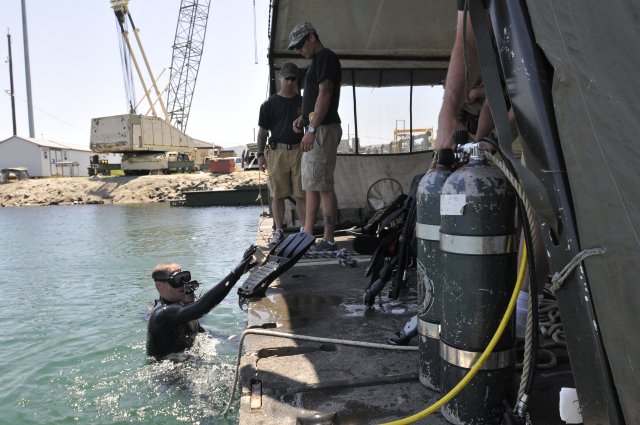A group of 85 Army engineer divers assigned to the 74th, 86th, 511th, 544th and 569th Engineer Dive Detachments, Special Troops Battalion, 7th Sustainment Brigade made the trek to Aberdeen Proving Ground, Md., to conduct Deep Blue, an annual deep water diving exercise that kicked off mid-May.
This year’s event took place at a man-made pond located at Aberdeen Proving Ground’s, or APG’s, Underwater Explosions and Testing site.
“The training is critical due to the risk factors associated with deep water diving,” said 1st Lt. John Maxwell, 569th Engineer Dive Detachment. “Diving platforms are set up on either side of the pond providing two training iterations for the group. Each diver logged 20-hours of time in the water by the end of the exercise.”
Divers spent three weeks training in self-contained underwater breathing apparatus, or scuba, and surface supply deep water dive scenarios with depths reaching 150 feet. Imagine jumping from a 15-story tall building and that will give you an idea of the depth involved in many of the diver’s missions.
Both diving modes are employed by the Army at a maximum depth of 190 feet.
The primary use for surface supplied diving include; underwater cutting and welding, waterfront facilities maintenance and port construction and rehabilitation. The use for scuba includes; inspections, search and recovery, river crossing operations and reconnaissance.
“Army divers work salvage and pier repair, port reopening and recovery operations,” explained 1st Lt. Maxwell. “They also maintain all navigable waterways in the United States working with the Army Corps of Engineers.”
The increased risk associated with deep water diving missions mandates the divers have be trained and readily available to conduct a variety of operations.
“This type of training is required for all Army divers,” said Capt. Joseph Lunn, commander, 86th Engineer Dive Detachment. “Divers work in water ranging in depth of 20 to 130 feet.”
A portable recompression chamber is brought with the divers to the training site from their base at Joint Base Langley-Eustis. It is set up on a diving platform and ready to use in case a diver experiences symptoms of compression illness.
“The physical risk for divers goes up substantially as the depth of the dive increases,” explained Maxwell. “Training is focused toward the diving supervisors so they can provide aid and assistance during deep water dives. It also prepares Soldiers for the next level of responsibility and career development.”
There are five levels of Army diver. The first four are used by the enlisted Soldier and include, Second Class Diver, Salvage Diver, First Class Diver, and Mater Diver. The fifth level is Diver Officer and is only for commissioned officers.










